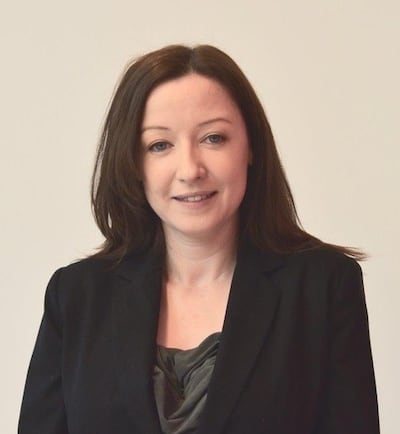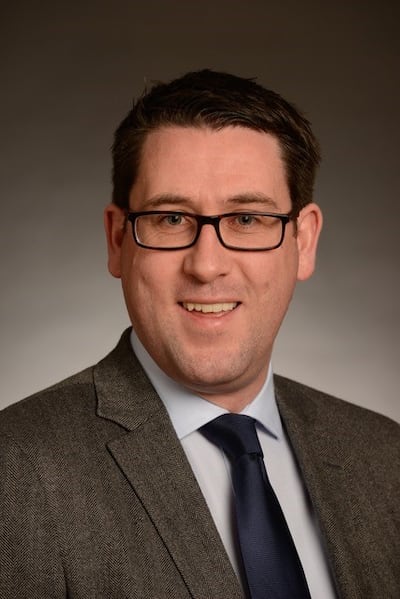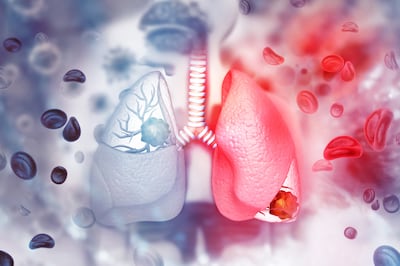Drugs used to prevent transplant rejection and lower cholesterol are just two treatments being repurposed for Irish patients with rare lung diseases.
Earlier this year, the Health Research Board announced a €1 million investment for the Rare Disease Clinical Trial Network. Led by professors Rachel Crowley and Cormac McCarthy at University College Dublin, the network aims to increase access to national and international trials, and treatments for patients with rare diseases.
“Rare diseases require a different perspective,” says Prof McCarthy, a consultant respiratory physician who runs the Rare Lung Disease Clinic at St Vincent’s University Hospital. Consultant endocrinologist Prof Crowley runs its rare bone disease and endocrine services.
Prof McCarthy previously worked at the Rare Lung Disease Consortium in the United States, based in Cincinnati, Ohio. “I have a special interest in rare lung diseases, and when talking about rare diseases, anything less than one in 2,000 people. But I also have a very special interest in these ultra-rare diseases which are really less than one in 50,000 people, maybe somewhere between 10 per million or even lower.”
READ MORE
He believes the trial network will prove extremely important for Irish patients. “As we start to understand the biology of these really rare diseases from a molecular biology perspective, it allows us to look for therapies. We can figure out either novel treatments, or whether we have available treatments that are already out there and developed and tested.”
Having repurposed, regularly used medications is really appealing. It’s so much better than trying to develop from scratch
Using existing drugs is a key element of rare disease research. “Getting investment in rare diseases is hard because you have very few patients,” explains Prof McCarthy. “So having repurposed, regularly used medications is really appealing. It’s so much better than trying to develop from scratch, and they have already been tested in humans.”
One successful example of a repurposed drug is being used by his own patients with Lymphangioleiomyomatosis (or LAM for short).
“It is exclusively women who get LAM disease which causes significant lung destruction over time. Some people can end up with respiratory failure on oxygen, and need a lung transplant. However, a drug called Sirolimus, which was originally for anti-transplant rejection, has been shown to work really well at a lower dose in LAM patients to stabilise their condition. It was actually a patient community in the US which funded the trial 10 years ago that led to this repurposed treatment.”
While the prevalence of LAM is reported at three to eight women per million, 42 women have been identified to date at the SVUH clinic. This, says Prof McCarthy, translates as a minimum of 16.5 women per million women, indicating that this condition remains under-diagnosed.
Laura McKenna was diagnosed with LAM in 2020 when she was 38. “I had absolutely no symptoms. I was healthy enough. I have asthma, but that was well managed. In August, I had the end of a cold and I started coughing and I felt I had pulled something in my back. To make a long story short, over the last couple of next couple of days I had extreme difficulty breathing, and I ended up in the emergency room in the Mater hospital at the height of Covid.”

An X-ray showed McKenna’s right lung had collapsed. It took two procedures, the second under anaesthetic, to get in re-inflated. “It’s quite unusual for a woman of my age to have a spontaneous lung collapse. But what I found out later is that there happened to be an emergency room doctor working that night who had come across a case of LAM disease 10 years previously. So I was sent for a CT scan — which is one of the ways to diagnose LAM — and they took a biopsy.”
Her diagnosis came as a shock. “When I came back in to have stitches removed the doctor said to me, ‘you have an appointment tomorrow with a professor who’s going to talk to you about your LAM disease’. As soon as he looked at me he knew he had put his foot in it. And when he left the room I did what you should never do, I got out my phone and Googled LAM, and one of the first times that comes up was a 10-year life expectancy, lung transplants, and all this really terrifying scary stuff. And that was a massive shock. I thought I would have to go home and tell my family I had 10 years to live.”
However, by the following morning, McKenna had done some more detailed, and less alarming research, which included information about Prof McCarthy’s clinic at SVUH. “So my aim going into the Mater was to get transferred because he was the expert in Ireland. And I thought that was going to be a challenge. But as it turned out, that was what they had planned to do. They had already been in contact and I had an appointment.

“By the time I saw him two weeks later my sister and I had researched different treatments and trials, including Sirolimus. That’s how where my brain had shifted. Once I had gotten over the shock of being diagnosed, with what I thought at the time was a terminal disease, my brain had shifted to ‘okay, what do we need to do?’
“I wanted to start the drug, but Dr McCarthy explained that before any decision on treatment could be taken, tests were needed to see how advanced the disease was. Every woman is different, but LAM causes cysts to grow in your lungs and then that breaks down the tissue in your lungs. Blood tests had to be sent off to Cincinnati in the US, and the results took a few weeks.”
Luckily, despite another debilitating partial lung collapse, which required another procedure and hospitalisation, those tests revealed that Laura’s LAM was still at a mild level.
“So we talked through the options, and I said I want to go on Sirolimus and he agreed. Like any drug it has the potential to have side effects — like it can cause high cholesterol or mouth ulcers for example — but to my mind, the benefits or the potential benefits outweighed any side effects.”
McKenna is a member of a support group, set up by another LAM patient, Emer Reilly Corrigan. “She was an incredible help to me when I was diagnosed. I have learned so much from her and other women. However, my main takeaway listening to the stories of other women is how differently LAM presented for every one of them. But the common theme was how long it took for them to be diagnosed. Some of them had been misdiagnosed, and because the symptoms can include fatigue and difficulty breathing, some had even been convinced that it was in their head.
There might be a woman who reads this article and thinks, ‘there might be something more to what’s going on with me’
“My diagnosis was such good luck. If my lung hadn’t collapsed, if that emergency doctor, who had previously seen a case of LAM, hadn’t been working that night, I might not have been diagnosed for a long time. This disease is under-diagnosed so there needs to be more awareness out there. There might be a woman who reads this article and thinks, ‘there might be something more to what’s going on with me’. "
McKenna has now been taking Sirolimus for almost a year and a half. “Every three months I go back to see Dr McCarthy and they do blood work, but the biggest indicator of your disease is a lung function test, where they test your breathing. And mine has been consistent. I’m slightly below normal lung function, but for LAM I’m doing really well, and as of yet I don’t have any other symptoms. So I am hoping that it is working, and my plan is to stay on it. My disease isn’t affecting my life or my work — I’m a trade union official with the Communications Workers Union who have been so supportive. I’m able to go about and do things as normal. If anything it has made me more conscious about exercising — about getting out walking. Aside from the health benefits, there may come a day when I won’t be able to go for a walk, or go for a walk without struggling to breathe. So I’m making sure I enjoy being able to do that now.”
LAM is only one of the rare diseases Prof McCarthy treats and researches. Another is Pulmonary Alveolar Proteinosis — PAP.
“I started working on this research when I was in the US and we’re now doing clinical trials and translational research at the clinic here.
“Your lung is full of different cells that are there to fight infection and keep the balance normal. But with PAP, you get a build-up of what is called surfactant, which is the type of fluid that lines your lungs to keep them from collapsing when they take a breath in and out. For example, premature babies don’t have enough surfactant, they’re born too early. Whereas in this condition, you’ve got too much surfactant, an excessive amount of surfactant and it clogs up your lungs.
“What we know about this condition is that in most cases you get an antibody against this protein that regulates the cells. And if you interfere with that, what happens is the cells don’t clear this lipid fluid easy enough. And then what happens is that builds up in your lungs, and the cells become stuffed full of these lipids. So we did research to look at the content of that type of lipid? And essentially, what we found was you get a lot of cholesterol there. It should only be about 10 per cent of the lipid in your lungs, but in these patients about 30 per cent of that lipid is cholesterol.”
The current treatment for PAP requires the lungs to be washed with saline fluid under general anaesthesia.
So this was kind of a bench to bedside moment, and then you bring it back to the bench
”It’s very invasive. You have to wash out the lungs with 50 litres of fluid. It’s very hard to do, and very few people have expertise anywhere in the world to do it.”
Prof McCarthy has been investigating how using statins — commonly used to lower cholesterol in blood — might be an effective treatment.
“We explored if it was a problem with the cells processing cholesterol. Then we went back to look at PAP patients who are taking statins. And we found a number of cases where patients who were on these normal medications for incidentally high cholesterol level had cleared a lot of the fluid on their lungs.
“So this was kind of a bench to bedside moment, and then you bring it back to the bench. We looked at statins again and we could show that they were essentially turning on a separate pathway in the cell to get rid of this cholesterol, and once you get rid of the cholesterol, these cells function properly; the cholesterol was what was slowing them down.”

Prof McCarthy says while they have now given a number of patients statin therapy, only a clinical trial will conclusively show if it is effective.
“Anecdotally their lung disease has stabilised, but we haven’t seen enough data to say they have improved or fully resolved yet.”
However, a clinical trial of statin therapy has been put on hold, while another worldwide trial for PAP patients is under way of a product called molgramostim, an inhaled GM-CSF (granulocyte-macrophage colony-stimulating factor), which has already proved effective in a number of studies. Most PAP cases are autoimmune and are associated with an autoantibody against GM-CSF that prevents the clearing of lung surfactant.
“We’d have loved to be doing a clinical trial on statins, but we also have to be realistic and to do what’s right for the patients,” says Prof McCarthy. “In rare disease communities we all work closely with other colleagues and companies, so we already have patients enrolled on the inhaled trial here, and we are recruiting. You can’t ever hang your hat on just one thing in rare disease, because you don’t know what’s going to work, so you must be open to all possibilities.”










